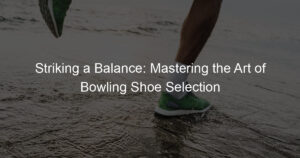When it comes to water shoes, one of the most important aspects is their ability to grip wet surfaces.
A slip or a fall could lead to injuries, especially when participating in water sports or traversing slippery terrain. I will explore the science behind the gripping capabilities of water shoes, from the physics to the materials used.
The Physics of Water Shoe Grip plays a significant role in determining the shoe’s performance on slippery surfaces. To maximize their grip, water shoes utilize clever design features and material selection.
Along with the materials used in water shoes, factors like the role of laces vs. slip-on and the impact of shoe weight also contribute to the overall grip performance.
Moreover, water shoes perform differently on diverse terrains, and ensuring health and comfort is crucial while wearing them.
The durability of water shoes is another important aspect, along with addressing frequently asked questions regarding their use and features.
Key Takeaways
- Grip performance depends on physics, design, and material choices
- Laces, slip-ons, and shoe weight influence overall grip
- Diverse terrains and comfort considerations impact water shoe effectiveness
The Physics of Water Shoe Grip
As a lover of water sports and activities, I’ve always been curious about what gives my water shoes their anti-slip properties. Well, it turns out that the grip of water shoes comes down to a balance between slip, traction, and grip, along with the materials used in creating them.
To understand how water shoes provide grip, let’s first talk about the factors that cause slip. When I’m walking on wet surfaces, water creates a barrier between my shoe sole and the surface, reducing friction and making it easier for my foot to slide.
Furthermore, water on the surface can sometimes act as a lubricant, which further increases the chances of slipping.
Now, let’s move on to how traction helps counteract slip. Traction, in simple terms, is the force that keeps my foot from skidding on a slippery surface. It is the force that opposes the motion of my foot against the surface, effectively helping me maintain a proper stance and preventing me from falling.
In water shoes, increased surface contact and friction between the shoe and the ground provide the needed traction for a good grip.
One of the key factors in achieving an effective grip with water shoes is the materials used in their construction. Most water shoes are made from rubber or synthetic materials that have a high coefficient of friction.
The rubber soles of these shoes not only provide better contact with the surface but also enable the shoes to adapt to the unevenness of wet terrains. Having a significantly higher friction coefficient, these materials play a crucial role in reducing slippage.
Some water shoes also have treads or patterns on their soles designed to channel water away from the contact points, allowing the sole to maintain a better connection with the surface.
These treads and patterns work together to increase traction and grip, making it safer and easier for me to walk on slippery surfaces.
To sum it up, the secret behind water shoe grip lies in the materials used, the design of the treads and patterns, and a good understanding of the balance between slip, traction, and grip.
It’s fascinating how these factors work together to make water shoes an essential part of my water adventures.
Materials Used in Water Shoes
Microfiber Construction
When I think about water shoes, microfiber construction often comes to mind. Microfiber materials are preferred for their lightweight and quick-drying properties. While wearing water shoes, I find that microfiber not only helps to avoid water retention but also offers excellent drainage.
Additionally, these fibers are tightly woven, making them resistant to abrasion and offering durability even in challenging aquatic environments.
Upper and Footbed Design
In my experience, the upper and footbed design plays a crucial role in improving the grip of water shoes. Typically, I’ve observed that water shoes use mesh or perforated materials in their uppers to enhance breathability and water drainage.
This helps in keeping my feet comfortable during aquatic activities.
The footbed, on the other hand, is usually designed with cushioning and anti-slip properties. This ensures that my feet remain secure and stable inside the shoes, especially when I’m walking on slippery surfaces.
Deck and Tread Considerations
One of the most important aspects of water shoe grip is the deck and tread design. When selecting a water shoe, I always look for one with a non-slip rubber outsole. This provides excellent traction on both wet and dry surfaces, making it easier for me to navigate tricky terrain.
Apart from the outsole material, I also pay attention to the tread pattern. A good pattern should have multidirectional lugs or grooves that can grip various surfaces effectively.
Some water shoes even feature siping in their tread, which disperses water more efficiently and further improves grip on wet surfaces.
Materials, proper upper and footbed designs, and the right deck and tread considerations significantly contribute to the overall grip of water shoes, making them perfect companions for various aquatic activities.
The Role of Laces vs. Slip-Ons
Laces vs. Easy Slip
In my experience, both laces and easy slip-on water shoes have their unique benefits when it comes to grip. Laces provide a more customizable and secure fit, allowing me to adjust the tightness to my preference.
This can improve the grip on slippery surfaces, as the shoe is less likely to shift or move around on my foot.
On the other hand, slip-on water shoes have a simpler design and can be less hassle to put on and take off. While they may not offer the same level of customization as laced shoes, many slip-on options have elastic or adjustable straps for a secure fit.
In fact, some slip-ons even have a sock-like design that hugs my foot, making them comfortable and providing a surprising amount of grip.
Laces:
- Customizable fit
- Can be tightened for a better grip
- May take more time to put on and take off
Slip-Ons:
- Easy to put on and take off
- Often has elastic or adjustable straps
- Sock-like designs can provide a snug, comfortable fit
Shoes: Tied vs United
In terms of grip, there’s a significant difference between wearing my water shoes with the laces tied and leaving them untied. When my laces are tied properly, the shoe fits snugly around my foot, and I feel more secure while navigating slippery surfaces.
Nevertheless, if my laces are untied or loosened over time, the shoe can shift unpredictably on my foot, increasing the chances of slipping. This is especially relevant in a watery environment, where shoes can become waterlogged, and conditions can change in an instant.
To sum up, it’s essential to make sure that my laced water shoes are securely tied to maximize their grip and reduce the risk of slipping. In contrast, slip-on water shoes don’t require this same level of attention, making them an appealing option for some situations.
The Impact of Shoe Weight on Grip
As I was researching the science behind water shoe grip, I discovered that shoe weight plays a crucial role in how well they grip wet surfaces. A lightweight shoe design allows for better performance and less strain on the wearer.
I believe that understanding this aspect of shoe design could even become a passion for some!
In the case of water shoes, keeping them lightweight is essential to providing an optimal grip on slippery surfaces. A lighter shoe provides the wearer with increased agility and the ability to make quick, precise adjustments to maintain balance on uneven and wet terrain.
This not only enhances grip performance but also reduces the likelihood of injury.
Another advantage of lightweight water shoes is the reduced absorption of water. By utilizing materials that dry quickly and don’t retain much water, the overall weight of the shoe is kept to a minimum.
This prevents the wearer from experiencing the cumbersome “waterlogged shoe” feeling and ensures that the shoe maintains its grip throughout its use.
To further illustrate how shoe weight impacts grip, consider the distribution of pressure on the shoe’s sole. A lighter shoe allows for more even pressure distribution across the entire surface area of the sole.
This increased contact with the ground, combined with a well-designed tread pattern, can significantly improve grip on wet surfaces.
In summary, lightweight water shoes offer advantages in terms of grip and performance. By minimizing the shoe’s overall weight and ensuring even pressure distribution, these shoes provide better grip and mobility for the wearer.
So the next time you’re shopping for water shoes, be sure to consider the weight of the shoe to fully enjoy the benefits of improved grip on wet surfaces.
Water Shoes for Different Terrains
Grip on Ice
I’ve noticed that water shoes with a good grip on ice are essential for winter activities. They provide stability and help prevent slipping on icy surfaces. Manufacturers usually achieve this by including rubber outsoles with a special pattern designed to grip ice effectively.
I’d recommend looking for water shoes that have specific ice-grip features when planning outdoor excursions on icy terrains.
Handling Snow
One of the challenges of walking on snowy grounds is the compacted snow that can accumulate under your shoes, making it slippery and difficult to walk. The good news is that there are water shoes that excel in their handling of snow.
These shoes often have outer soles with deep lugs for better traction, and some even use materials like Vibram Arctic Grip to improve grip on wet, icy surfaces. I always opt for shoes with these qualities when it comes to snowy conditions.
Ideal for Hiking
For those who love hiking, a water shoe that provides excellent grip on various surfaces is crucial. On my hikes, I prefer shoes that have an aggressive tread pattern and sticky rubber soles for maximum traction.
This ensures that I can confidently navigate my way through forests, rocky trails, and even slippery riverbanks without compromising my safety.
Stylish City Explorations
Sometimes, I like to explore the urban landscape in style while maintaining the benefits of water shoes with a good grip. I’ve found that some manufacturers offer fashionable designs for city wear, incorporating both form and function.
These stylish water shoes typically have excellent traction, similar to that of tires on wet roads, so I can enjoy my urban adventures without worrying about slips and falls.
Health and Comfort Considerations
Debris Protection
One thing I always consider when looking for water shoes is debris protection. It’s essential, especially when I’m walking on rocky or uneven surfaces, where it’s easy for small rocks or other debris to get into the shoes.
A good water shoe should have a snug fit around the ankle and a covered toe area, which provides added protection. Having this feature has saved my feet more than once from unwanted discomfort and minor injuries.
Breathability Impacts
Another critical factor for me is breathability. I want my water shoes to be comfortable and prevent excessive sweating or trapped moisture. A great water shoe should have a breathable upper material, like mesh or quick-drying fabric, which allows water to drain easily and air to circulate.
This helps keep my feet dry and comfortable throughout my water adventures. I can’t tell you the number of times having breathable water shoes has made my day more enjoyable.
Minimalist Shoes and Knees
Lastly, let’s talk about minimalist shoes and their impact on our knees. As someone who prefers lightweight and flexible shoes, I often opt for minimalist designs. Over time, I’ve found that wearing minimalist water shoes can have positive effects on my overall knee health.
They allow my feet to move more naturally and take on more of the impact, which can lead to better joint function and stability. Nonetheless, it’s essential to transition gradually and allow your body to adjust to wearing minimalist shoes to avoid potential injuries.
Several factors contribute to a water shoe’s health and comfort. Prioritizing debris protection and breathability and understanding the impact of minimalist shoes on our knees can ensure a more enjoyable water adventure.
Durability of Water Shoes
Water shoes are essential for outdoor activities, especially when we are near water bodies or wet surfaces. When I’m considering the durability of water shoes, there are a few factors I need to keep in mind.
Firstly, the material of the shoes plays an important role in their durability. High-quality materials like neoprene, mesh, and rubber are often used to make water shoes robust and long-lasting.
These materials can withstand harsh environments and resist wear and tear from water, sand, and other elements we may encounter in our adventures.
Secondly, the construction and design of the shoes can contribute to their durability. A well-constructed water shoe will have features such as reinforced stitching, quality insoles, and good arch support, which can help extend the life of the shoe.
It’s not just about the materials but also how they are put together that makes a difference.
Also, some water shoes come with removable parts, such as insoles or liners. This can be a huge plus for durability, as it allows me to replace the worn-out parts without having to buy a new pair of shoes.
It’s also great for cleaning and maintaining hygiene since these removable parts can be washed and dried easily, keeping my shoes fresh and ready for the next adventure.
Lastly, proper maintenance and care are essential for ensuring the durability of water shoes. I make sure to rinse my shoes thoroughly after each use and allow them to air dry completely before storing them.
This helps prevent any buildup of dirt and grime that can weaken the materials and reduce the lifespan of the shoes.
In conclusion, by considering the material, design, and maintenance, I can ensure the durability of my water shoes and enjoy my outdoor activities without any worries about their performance.
Frequently Asked Questions
How do water shoes provide traction?
Water shoes provide traction by having specially designed soles that create friction between the shoe and the wet surface. The sole often includes rubber or silicone materials that have a natural ability to stick to slippery surfaces.
Patterns or grooves on the soles also help disperse water, allowing for better contact with the ground and resulting in improved grip.
What materials enhance grip in water shoes?
Some materials that enhance grip in water shoes include natural rubber, thermoplastic rubber (TPR), silicone, and certain synthetic materials. These materials are flexible, durable, and capable of maintaining their gripping capabilities when wet.
They also often have high adhesion properties that help them adhere to wet surfaces, providing greater traction in slippery environments.
What’s the role of sole design in the grip?
The role of the sole design in water shoes is crucial for improving grip on wet surfaces. The pattern and shape of the soles can significantly affect traction performance. Certain designs, like deep grooves, help channel water away from the shoe, preventing hydroplaning.
Furthermore, multidirectional patterns and small channels offer better contact with the surface, effectively improving traction during various movements.
How do water shoes maintain grip on wet surfaces?
Water shoes maintain a grip on wet surfaces by combining specially designed soles with materials that offer better traction in wet environments. The soles may include anti-slip patterns and materials that prevent slipping on surfaces with water, algae, or other slippery substances.
These shoes also often have quick-drying properties that keep excess water out and reduce the chances of losing grip due to saturation.
Are there different grips for various water activities?
Yes, there are different grip designs specialized for various water activities. For example, some water shoes have siping or razor-cut grooves that are ideal for activities like sailing, where the grip on wet, smooth surfaces is critical.
On the other hand, water shoes designed for hiking and water exploring may use lug patterns with deeper, well-spaced grooves for better traction on rocks, mud, and sand.
How can I increase the lifespan of my water shoe grip?
To increase the lifespan of your water shoe grip, follow proper care and maintenance guidelines. Rinse and clean your shoes after each use to remove sand, dirt, or any debris that might affect traction. Avoid exposing your shoes to direct sunlight for extended periods, as UV radiation can cause material degradation.
Additionally, storing your shoes in a cool, dry place when not in use and routinely inspecting them for signs of wear can help extend their lifespan.
Regularly replacing worn-out shoes will ensure you always have the best grip available during your water activities.









